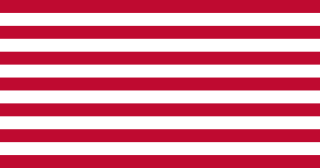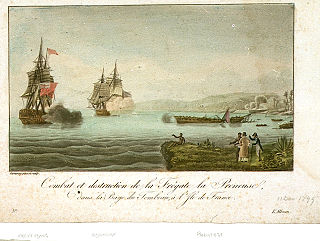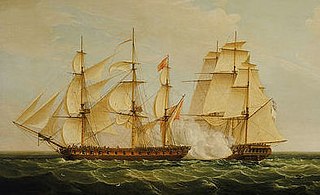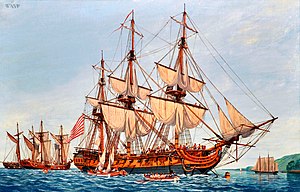
The second USS Boston was a 24-gun frigate, launched 3 June 1776 by Stephen and Ralph Cross, Newburyport, Massachusetts, and completed the following year. In American service she captured a number of British vessels. The British captured Boston at the fall of Charleston, South Carolina, renamed her HMS Charlestown, and took her into service. She was engaged in one major fight with two French frigates, which she survived and which saved the convoy she was protecting. The British sold Charlestown in 1783, immediately after the end of the war.
The continental Navy frigate USS Deane was originally a ship secretly ordered by the American Commissioners from the Nantes shipowner Jean Peltier Dudoyer.

The Continental Navy was the navy of the Thirteen Colonies during the American Revolutionary War. Founded on October 13, 1775, the fleet developed into a relatively substantial force throughout the Revolutionary War, owing partially to the substantial efforts of the Continental Navy's patrons within the Continental Congress. These Congressional Patrons included the likes of John Adams, who served as the Chairman of the Naval Committee until 1776, when Commodore Esek Hopkins received instruction from the Continental Congress to assume command of the force.

The first USS Essex of the United States Navy was a 36-gun or 32-gun sailing frigate that participated in the Quasi-War with France, the First Barbary War, and in the War of 1812. The British captured her in 1814 and she then served as HMS Essex until sold at public auction on 6 June 1837.
USS Saratoga was a sloop in the Continental Navy. She was the first ship to honor the historic Battle of Saratoga. Having disappeared in 1781, her fate remains a mystery.

HMS Drake was a Royal Navy 14-gun ship rigged sloop-of-war with a displacement of 275 tons burthen. Originally named the Royal Oak, she was built in New England in 1775 by John Wharton from Philadelphia. She first sailed between London and Stettin as a tobacco-ship. She was then sold in 1776 and renamed Resolution. Captained by Edward Hawker, the ship traded between London, Boston, and Cork. On 4 March 1777 the British navy purchased her at Plymouth for 3,000 pounds sterling. She completed fitting out as a warship on 24 May 1777. She became the ship-rigged sloop-of-war Drake with either 14, 18 or 20 guns. From July 17, 1777, she served in the American Revolutionary War. Her first mission was protecting the packet-boats between Harwich and Gorée

HMS Berwick was a 74-gun Elizabeth-class third rate of the Royal Navy, launched at Portsmouth Dockyard on 18 April 1775, to a design by Sir Thomas Slade. She fought the French at the Battle of Ushant (1778) and the Dutch at the Battle of Dogger Bank (1781). The French captured her in the action of 8 March 1795 during the French Revolutionary Wars and she served with them with some success then and at the start of the Napoleonic Wars until the British recaptured her at the Battle of Trafalgar. Berwick sank shortly thereafter in a storm.

HMS Lively was a 20-gun post ship of the Royal Navy, launched in 1756. During the Seven Years' War she captured several vessels, most notably the French corvette Valeur in 1760. She then served during the American Revolutionary War, where she helped initiate the Battle of Bunker Hill. The French captured her in 1778, but the British recaptured her in 1781. She was sold in 1784.

HMS Lowestoffe was a 32-gun fifth-rate frigate of the Royal Navy. Built during the latter part of the Seven Years' War, she went on to see action in the American War of Independence and the French Revolutionary War, and served often in the Caribbean. A young Horatio Nelson served aboard her shortly after passing his lieutenant's examination.

Sir Hugh Cloberry Christian KB was an officer of the Royal Navy who saw service during the American War of Independence, and the French Revolutionary Wars.

The Sirène was a 40-gun Coquille class frigate of the French Navy. She took part in a number of campaigns and actions before she was badly damaged in a battle on 22 March 1808. Refloated after being beached to avoid capture, she was hulked. Sirène was broken up in 1825.

HMS Adamant was a 50-gun Portland-class fourth rate warship of the British Royal Navy. She served during the American War of Independence, the French Revolutionary Wars, and the Napoleonic Wars in a career that spanned thirty years.
Censeur was a 74-gun Pégase-class ship of the line of the French Navy, launched in 1782. She served during the last months of the American War of Independence, and survived to see action in the French Revolutionary Wars. She was briefly captured by the British, but was retaken after a few months and taken back into French service as Révolution. She served until 1799, when she was transferred to the Spanish Navy, but was found to be rotten and was broken up.

HMS Prince William was a 64-gun third-rate ship of the line of the Royal Navy. She had previously been Guipuzcoano, an armed 64-gun ship of the Spanish (Basque) mercantile Guipuzcoan Company of Caracas. She was also known by the religious name of Nuestra Señora de la Asunción.

HMS Surprise was a 28-gun Enterprise-class sixth-rate frigate of the Royal Navy, which served throughout the American Revolutionary War and was broken up in 1783.

HMS Sibyl was a 28-gun Enterprise-class sixth-rate frigate of the Royal Navy. Sibyl was renamed HMS Garland in 1795.

HMS Hyaena was a 24-gun Porcupine-class post-ship of the Royal Navy launched in 1778. The French captured her in 1793, took her into service as Hyène, and then sold her. She became a privateer that the British captured in 1797. The Royal Navy took her back into service as Hyaena and she continued to serve until the Navy sold her in 1802. The shipowner Daniel Bennett purchased her and renamed her Recovery. She made seven voyages as a whaler in the British southern whale fishery and was broken up 1813.

HMS Ceres was an 18-gun sloop launched in 1777 for the British Royal Navy that the French captured in December 1778 off Saint Lucia. The French Navy took her into service as Cérès. The British recaptured her in 1782 and renamed her HMS Raven, only to have the French recapture her again early in 1783. The French returned her name to Cérès, and she then served in the French Navy until sold at Brest in 1791.

HMS Pearl was a fifth-rate, 32-gun British Royal Navy frigate of the Niger-class. Launched at Chatham Dockyard in 1762, she served in British North America until January 1773, when she sailed to England for repairs. Returning to North America in March 1776, to fight in the American Revolutionary War, Pearl escorted the transports which landed troops in Kip's Bay that September. Much of the following year was spent on the Delaware River where she took part in the Battle of Red Bank in October. Towards the end of 1777, Pearl joined Vice-Admiral Richard Howe's fleet in Narragansett Bay and was still there when the French fleet arrived and began an attack on British positions. Both fleets were forced to retire due to bad weather and the action was inconclusive. Pearl was then despatched to keep an eye on the French fleet, which had been driven into Boston.

Experiment was a 50-gun ship of the line of the British Royal Navy. Captured by Sagittaire during the War of American Independence, she was recommissioned in the French Navy, where she served into the 1800s.


















